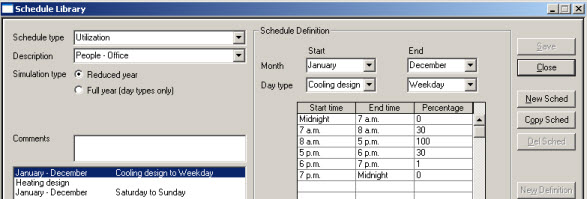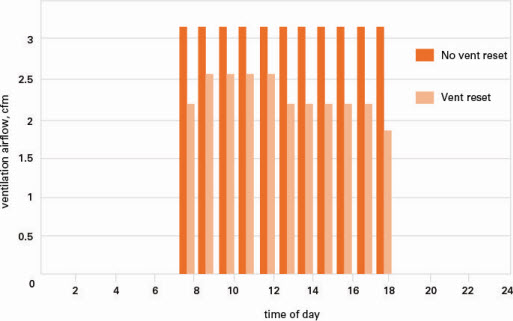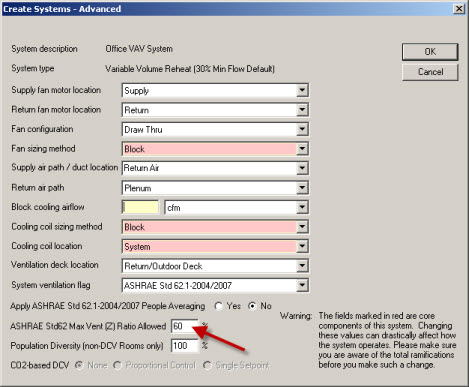C.D.S. Newsletter March 2011
In this issue ...
This issue focuses on ASHRAE Standard 62.1, Ventilation for Acceptable Indoor Air Quality, and how it is implemented in TRACE™ 700. First, we have an article that demonstrates how to complete the "Ventilation Rate Procedure" (Section 6.2) and how to enable the calculations in TRACE. Next, we have some Frequently Asked Questions about TRACE and ASHRAE Standard 62.1. Finally, we have some additional ASHRAE Standard 62.1 resources to help you learn even more (and earn CEUs).
- TRACE™ 700 and ASHRAE Standard 62.1
- Frequently Asked Questions: TRACE 700 and ASHRAE Standard 62.1
- Additional ASHRAE Standard 62.1 Resources
- Free on-demand course: ASHRAE Standard 62.1-2004—Ventilation Rate Procedure
TRACE™ 700 and ASHRAE Standard 62.1
Ventilation refers to the introduction of an adequate amount of fresh outdoor air to dilute contaminants that are generated inside the building (by people, equipment, processes, or furnishings). This requires the removal of an equal quantity of air from the building.
The “Ventilation Rate Procedure” (Section 6.2) in ASHRAE Standard 62.1, Ventilation for Acceptable Indoor Air Quality, prescribes the quantity of outdoor air that must be delivered to each zone, based on the expected use of that zone, and then prescribes how to calculate the outdoor airflow needed at the system-level intake.
To demonstrate this procedure, we’ll use an example VAV system with three breathing zones. We’ll also discuss how these calculations are implemented in TRACE™ 700. Read the article... [PDF]
Frequently Asked Questions: TRACE 700 and ASHRAE Standard 62.1
For a printer-friendly version of these FAQs, click here.
What’s the difference between ASHRAE Std 62.1 2004/2007 and ASHRAE Std 62.1 2004/2007 w/Vent Reset?
These two options are available from the System Ventilation Flag field on the Create Systems - Advanced screen.

When ASHRAE Std 62.1 2004/2007 is selected, the outdoor air intake flow (Vot) is maintained at a constant flow rate established at design conditions while TRACE performs the building simulation calculations.
When ASHRAE Std 62.1 2004/2007 w/Vent Reset is selected, TRACE recalculates the outdoor air intake flow on an hourly basis as the population changes in the individual rooms.
In the following example, the population in the West Office is changing during a weekday according to the People – Office schedule.


The graph below shows the difference in the ventilation airflow (cfm) for a typical weekday in January without ventilation reset (alt 1) and with ventilation reset (alt 2).

Why does the system call for 100% outdoor air when ASHRAE Standard 62.1 is implemented?
This condition occurs if at any time the zone outdoor airflow (Voz) is equal to the lowest zone primary airflow value expected at the design condition analyzed (Vpz).
To prevent this situation from occurring, you can set a maximum outdoor air fraction limit in TRACE. This value can be entered in the ASHRAE Std62 Max Vent (Z) Ratio Allowed field on the Create Systems-Advanced screen.

To see an example of this scenario, click here.
What is the “right” value for the Maximum Vent (Z) Ratio Allowed field?
It is left to your discretion to define the Max Vent (Z) Ratio Allowed value. While reducing the ventilation fraction decreases the outdoor air intake flow, it increases the fan energy because of the higher system airflow. It also increases the amount of VAV reheat required (if present) to temper the air delivered to the affected zones, and it may lead to overcooling in the affected zones without reheat.
Additional ASHRAE Standard 62.1 Resources
Trane has been actively involved with the development of ASHRAE Standard 62.1. We have created the following resources to help you gain a better understanding of this important standard:
Engineers Newsletter Live
The following free, on-demand courses qualify for 1.5 LEED-specific continuing education (CE) hours from the U.S. Green Building Council (USGBC).
- ASHRAE Standards 62.1 and 90.1, and VAV Systems [On-demand course]
- ASHRAE Standard 62.1-2004: Ventilation Rate Procedure [On-demand course]
Engineers Newsletters
The following articles discuss aspects of ASHRAE Standard 62.1.
C.D.S. Newsletter June 2011


